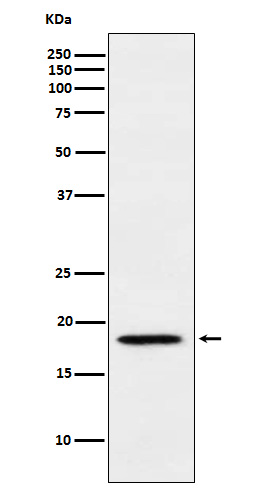Anti-MTH1 Rabbit Monoclonal Antibody
- SPECIFICATION
- CITATIONS
- PROTOCOLS
- BACKGROUND

Application
| WB, IHC, IF, ICC, IP, FC |
|---|---|
| Primary Accession | P36639 |
| Host | Rabbit |
| Isotype | IgG |
| Reactivity | Human |
| Clonality | Monoclonal |
| Format | Liquid |
| Description | Anti-MTH1 Rabbit Monoclonal Antibody . Tested in WB, IHC, ICC/IF, IP, Flow Cytometry applications. This antibody reacts with Human. |
| Gene ID | 4521 |
|---|---|
| Other Names | Oxidized purine nucleoside triphosphate hydrolase, 3.6.1.56, 2-hydroxy-dATP diphosphatase, 7, 8-dihydro-8-oxoguanine triphosphatase, 8-oxo-dGTPase, Methylated purine nucleoside triphosphate hydrolase, 3.6.1.-, Nucleoside diphosphate-linked moiety X motif 1, Nudix motif 1, NUDT1, MTH1 {ECO:0000303|PubMed:7713500} |
| Calculated MW | 18 kDa |
| Application Details | WB 1:500-1:2000 IHC 1:50-1:200 ICC/IF 1:50-1:200 IP 1:50 FC 1:100 |
| Contents | Rabbit IgG in phosphate buffered saline, pH 7.4, 150mM NaCl, 0.02% sodium azide and 50% glycerol, 0.4-0.5mg/ml BSA. |
| Clone Names | Clone: 22N23 |
| Immunogen | A synthesized peptide derived from human MTH1 |
| Purification | Affinity-chromatography |
| Storage | Store at -20°C for one year. For short term storage and frequent use, store at 4°C for up to one month. Avoid repeated freeze-thaw cycles. |
| Name | NUDT1 |
|---|---|
| Synonyms | MTH1 {ECO:0000303|PubMed:7713500} |
| Function | Oxidized purine nucleoside triphosphate hydrolase which is a prominent sanitizer of the oxidized nucleotide pool (PubMed:10608900, PubMed:12857738, PubMed:22556419, PubMed:24695224, PubMed:24695225, PubMed:26238318, PubMed:28679043, PubMed:7713500, PubMed:8226881). Catalyzes the hydrolysis of 2-oxo-dATP (2-hydroxy-dATP) into 2-oxo-dAMP (PubMed:10373420). Also has a significant hydrolase activity toward 2- oxo-ATP, 8-oxo-dGTP and 8-oxo-dATP (PubMed:10373420, PubMed:11139615). Through the hydrolysis of oxidized purine nucleoside triphosphates, prevents their incorporation into DNA and the subsequent transversions A:T to C:G and G:C to T:A (PubMed:10373420, PubMed:10608900, PubMed:11756418, PubMed:12857738, PubMed:16607562, PubMed:24695224, PubMed:24695225, PubMed:26999531, PubMed:28035004, PubMed:8226881). Also catalyzes the hydrolysis of methylated purine nucleoside triphosphate preventing their integration into DNA (PubMed:30304478, PubMed:32144205). Through this antimutagenic activity protects cells from oxidative stress (PubMed:10608900, PubMed:12857738, PubMed:24695224, PubMed:24695225, PubMed:30304478, PubMed:32144205, PubMed:7713500, PubMed:8226881). |
| Cellular Location | [Isoform p18]: Cytoplasm, cytosol. Mitochondrion matrix. Nucleus. Note=Mostly present in cytosol (PubMed:7782328). A minor proportion is mitochondrial (PubMed:7782328) A very small amount of the protein is associated with nuclei (PubMed:7782328). |
| Tissue Location | Widely expressed with highest expression in thymus, testis, embryo and proliferating blood lymphocytes |

Thousands of laboratories across the world have published research that depended on the performance of antibodies from Abcepta to advance their research. Check out links to articles that cite our products in major peer-reviewed journals, organized by research category.
info@abcepta.com, and receive a free "I Love Antibodies" mug.
Provided below are standard protocols that you may find useful for product applications.
If you have used an Abcepta product and would like to share how it has performed, please click on the "Submit Review" button and provide the requested information. Our staff will examine and post your review and contact you if needed.
If you have any additional inquiries please email technical services at tech@abcepta.com.













 Foundational characteristics of cancer include proliferation, angiogenesis, migration, evasion of apoptosis, and cellular immortality. Find key markers for these cellular processes and antibodies to detect them.
Foundational characteristics of cancer include proliferation, angiogenesis, migration, evasion of apoptosis, and cellular immortality. Find key markers for these cellular processes and antibodies to detect them. The SUMOplot™ Analysis Program predicts and scores sumoylation sites in your protein. SUMOylation is a post-translational modification involved in various cellular processes, such as nuclear-cytosolic transport, transcriptional regulation, apoptosis, protein stability, response to stress, and progression through the cell cycle.
The SUMOplot™ Analysis Program predicts and scores sumoylation sites in your protein. SUMOylation is a post-translational modification involved in various cellular processes, such as nuclear-cytosolic transport, transcriptional regulation, apoptosis, protein stability, response to stress, and progression through the cell cycle. The Autophagy Receptor Motif Plotter predicts and scores autophagy receptor binding sites in your protein. Identifying proteins connected to this pathway is critical to understanding the role of autophagy in physiological as well as pathological processes such as development, differentiation, neurodegenerative diseases, stress, infection, and cancer.
The Autophagy Receptor Motif Plotter predicts and scores autophagy receptor binding sites in your protein. Identifying proteins connected to this pathway is critical to understanding the role of autophagy in physiological as well as pathological processes such as development, differentiation, neurodegenerative diseases, stress, infection, and cancer.


